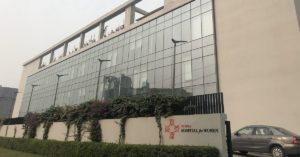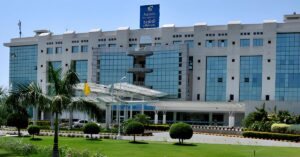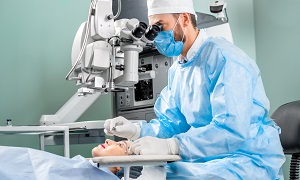Best Doctors in India for LASIK
Best Hospitals in India for LASIK
- City: Mumbai, India
Hospital Highlights:
- Fortis Hiranandani hospital was established in 2007.
- The hospital is an advanced tertiary care, multi-specialty hospital equipped with 149 beds.
- The hospital is equipped with a super ICU to provide emergency medical care to critically ill patients.
- The hospital is NABH accredited.
- The critical care facility in the hospital is augmented with the state-of-the-art facilities that facilitate speedier diagnosis and efficient monitoring.
- The hospital provides specialty medical services in cardiology, orthopedic science, pediatric science, neurology, diabetic care, urology, nephrology, ENT, obstetrics, gynecology, cosmetic surgery, bariatric surgery, neuro and spine care.
- City: Gurugram, India
Hospital Highlights:
- W Pratiksha Hospital, Gurugram, is one of the best hospitals in the NCR region. It is also a top hospital in India for IVF. Since its inception, the hospital has performed over 5500 successful IVFs. The hospital also specializes in gynecology.
- With over 20 years of experience in providing quality healthcare, the hospital is known as one of the most trusted and valued health providers in India.
- Equipped with world-class medical facilities and advanced technology, the hospital’s doctors and clinicians also have a track record of delivering excellent results. The hospital is also known for focusing on preventive well-being as much as on curative treatment.
- The hospital has earned the trust of its patients, by providing the best available treatments at affordable costs.
- City: Gurugram, India
Hospital Highlights:
- Paras hospital was established in 2006 and is the 250 bedded flagship hospital of Paras Healthcare.
- The is supported by a team of doctors of international and national repute.
- The hospital is NABH accredited and also the first hospital in the region to have a NABL accredited laboratory.
- The hospital provides specialty medical services in around 55 departments including Neurosciences, Joint Replacement, Mother & Child Care, Minimal Invasive Surgery, Gynecology and Obstetrics, Ophthalmology, Dermatology, Endocrinology, Rheumatology, Cosmetic and Plastic surgery.
- The hospital is equipped with state-of-the-art technologies.
- City: Kolkata, India
Hospital Highlights:
- Fortis Hospital, Anandapur, Kolkata is a world-class super-speciality equipped with the latest technologies in the medical world.
- The hospital is NABH accredited.
- This state-of-the-art facility specializes in cardiology and cardiac surgery, urology, nephrology, neurosciences, orthopaedics, digestive care, emergency care and critical care.
- The hospital, governed by integrated Building Management System (IBMS), has a pneumatic chute system, for quick vertical and horizontal transportation between floors, facilitating speedy transfer of patient specimens, documents, reports, and medicines to the concerned departments.
- The hospital also has a nephrology department with over 28 advanced dialysis units.
- City: Mumbai, India
Hospital Highlights:
- SL Raheja hospital is a 140-bed multi-specialty tertiary care hospital that is being managed by Fortis Healthcare Ltd.
- The hospital is a benchmark in healthcare and medical facilities in the neighborhood of Mahim & the western suburbs.
- L.Raheja Hospital, Mahim has one of the most effective ICU and Casualty care services.
- The hospital provides specialty medical services in Cardiology, Oncology, Neurology, Orthopedics, Mother & Child Care, and in Diabetes.
- City: Mumbai, India
Hospital Highlights:
- Wockhardt Hospitals were established in the year 1973, originally called First Hospitals and Heart Institute.
- Wockhardt Hospitals are super specialty health care networks in India, nurtured by Wockhardt Ltd, India’s 5th largest Pharmaceutical and Healthcare company.
- Wockhardt Hospitals is associated with Partners Harvard Medical International, an international arm of Harvard Medical School, USA.
- Wockhardt Heart Hospital performed India’s first endoscopic heart surgery.
- The hospital has a state-of-the-art infrastructure equipped with the latest technologies and modern equipment.
- It has special Centers of Excellence dedicated to the major specialties to provide hassle-free and high-quality clinical care.
- City: Gurugram, India
Hospital Highlights:
- The CK Birla Hospital in Gurugram is a NABH-accredited multi-specialty hospital.
- The hospital strives to increase the quality of healthcare by focusing on UK NHS nurse and midwife training requirements. Policies and practices derived from the National Institute for Health and Treatment Excellence (NICE) recommendations in the United Kingdom ensuring that a strong focus on safety, high-quality clinical care, and sanitation is maintained.
- The hospital’s cutting-edge technology and facilities allow for real-time communication and seamless collaboration among caregivers, ensuring accuracy and the best possible results. Those with foreign experience and accreditations make up part of the hospital’s team of clinicians.
- City: Ahmedabad
Hospital Highlights:
- As a member of the Apollo Hospitals Group, Apollo Hospitals International Limited, Ahmedabad is one of the most popular and sought-after medical facilities in Gujarat.
- Through its 6 Centres of Excellence and various affiliated branches, which cover all specialties and subspecialties, the hospital provides the most advanced clinical services.
- Since its inception in 2003, the hospital has been providing each patient with the most up-to-date medical equipment and state-of-the-art technology.
- With more than 150 successful organ transplants, including liver and renal transplants, the facility has been able to build a strong and extensive organ transplant program.
- In addition to performing 600 surgeries and caring for over 1800 patients on an IP basis, the hospital sees more than 18,000 patients on average in the outpatient department.
- With one of the biggest cardiology teams in the area, the hospital provides state-of-the-art regional care treatment in Cardiac Sciences.
- Additionally, the hospital offers a broad range of Neuro Interventional techniques to help stroke patients recover more quickly.
- City: Noida, India
Hospital Highlights:
- Jaypee Hospital is the flagship hospital of the Jaypee Group.
- This hospital has commissioned 525 beds in the first phase and has been planned and designed as a 1200 bedded multi-specialty facility.
- It holds the accreditation of the NABH and NABL.
- The hospital has state-of-the-art infrastructure equipped with the latest technologies and modern equipment like 64 Slice PET CT, Dual Head 6 Slice SPECT CT, Gamma Camera, and Da Vinci Robotic Surgery for comprehensive robotic surgical solutions.
- It has special Centers dedicated to the major specialties to provide hassle-free and high-quality clinical care.
- City: Mumbai, India
Hospital Highlights:
- Reliance Hospital is one of the best super-specialty care hospitals in Navi Mumbai.
- The main purpose of this hospital is to become a trustworthy place for the best health and hope for society. The hospital is well connected to the suburbs of Mumbai and Navi Mumbai.
- The hospital has various specialty departments, viz., Accident & Emergency, Anesthesiology, Dental Services, Dermatology, Diabetology, Dietetics Nutrition, Endocrinology, ENT, Gastroenterology, General Surgery, Gynaecology And Obstetrics, Hepato Pancreato Biliary Surgery, Infectious Disease, Internal Medicine, Interventional Radiology, Laboratory Medicine, Minimal Access Laparoscopic Surgery, Nephrology, Neurosciences, Opthalmology, Orthopaedics, Paediatrics, Pain Management Palliative Care, Physical Medicine Rehabilitation, Plastic And Reconstructive Surgery, Psychiatry, Pulmonary Medicine, Radiology, Rheumatology, Transplant, Urology Andrology, Vascular Surgery
LASIK
LASIK (Laser-assisted in situ keratomileusis) is the most commonly performed laser eye surgery used to treat eye disorders, viz. myopia (nearsightedness), hyperopia (farsightedness) and astigmatism. Like other types of refractive surgeries, this procedure can reshape the front surface (cornea) of the eye to enable light entering the eye to focus on the retina without the need for glasses or contact lenses.
LASIK is a pain-free procedure and it requires only around 15 minutes treating both the eyes. One’s vision can improve immediately and can stabilize in as little as 24 hours. During this surgery, a special type of laser is used to precisely change the shape of the dome-shaped clear tissue in the cornea.
Purpose
The purpose of LASIK is to treat one of these vision problems-
- Myopia (Nearsightedness): When a person’s eyeball is slightly longer than normal or when the cornea curves too sharply, light rays focus in front of the retina and end up blurring distant vision. In this condition you can see close objects quite clearly but those that are far away can appear blurry.
- Farsightedness (Hyperopia): When your eyeball is shorter than average or your cornea is too flat, light focuses behind the retina instead of on it and this ends up making near vision and sometimes even distant vision quite blurry.
- Astigmatism: When the cornea curves or flattens unevenly, it results in a disorder called astigmatism which can disrupt the focus of near and distant objects.
Preparation
Before LASIK you would need to meet with a coordinator or eye surgeon who can talk to you regarding what to expect during and after the procedure. You will need to provide your medical history and then undergo a full eye exam. Some tests to measure the thickness of your eye, refraction as well as eye pressure will also be included.
If you are wearing contact lenses, it is important not to wear them for at least three weeks until you have had your evaluation. LASIK surgery is considered an elective surgery which is why most insurance companies will be unwilling to cover its cost. You might need to pay the expenses out of your pocket.
It is also important that you don’t use eye makeup, cream, perfumes or lotions on the day before and after your surgery. You might also receive instructions from your doctor to clear your eyelashes daily or more in the days leading up to your surgery in order to remove the debris as well as minimize the risk of infection.
During the surgery
LASIK surgery usually won’t take longer than 30 minutes. During this procedure, you are supposed to lie on your back in a reclining chair. You might also be given medicine which will provide relaxation.
After some numbing eye drops are placed on your eye, your doctors will use an instrument to hold the eyelids open. Then a suction ring will be placed on your eye, before cutting the corneal flap. This might cause a feeling of pressure and your vision might dim a bit.
Your eye surgeon will next use a small blade or cutting laser to cut a small hinged flap away from the front of your eye. Folding back this flap can allow your surgeon to access the part of your cornea which needs reshaping.
Your surgeon will then reshape parts of your cornea using a programmed laser. You will be asked to put your focus on a point of light during the procedure. This helps keep your eye fixed, while the laser can reshape the cornea.
If you require LASIK surgery in both the eyes, generally your surgeon will conduct the procedure on the same day.
After the surgery
Your eyes will be dry and your doctor will give you prescription eye drops in order to prevent infection and inflammation, as well as drops to help keep the eyes moist. You might also experience a slight burning feeling or blurry vision for a brief period when are using them. Also remember not to use any kind of eye drops unless you’ve consulted your doctor about them.
Do not swim or use a hot tub for at least two weeks post-surgery. You can also consider getting a plastic shield for the protection of your eyes while you’re sleeping for a few days.
Though you will be able to see right after the surgery itself, you won’t experience a clear vision right away. It takes around two to three months after the surgery is performed and your eye can heal back to normal. Your chances for improved vision also depend on how good your vision was before your surgery.
Around 80 percent of people, who have undergone LASIK refractive surgery, haven’t required their glasses or contact lenses for the majority of their activities.
Benefits
- LASIK has been around for over 2 decades and 96 percent of patients are able to reach their vision goals within a short time.
- There is almost no pain involved in the surgery.
- No bandages or stitches are involved.
- Even if your vision changes with age, your doctor will be able to adjust it.
- After the operation, you will hardly need to use your glasses or contact lenses.
Risks
- Dry Eyes- LASIK surgery can cause a temporary decrease in the production of tears. Due to this, for around six months after the surgery, your eyes may feel unusually dry as they heal. This can cause a reduction in the quality of your vision.
- Undercorrections- If the laser ends up removing too little tissue from your eyes, the clearer vision results you were expecting will not be achieved. Undercorrections are more common among nearsighted people. If this happens, you might need to undergo another LASIK Procedure within one year to remove more tissue.
- Overcorrections- It is possible that the laser will remove too much tissue from your eye which can lead to overcorrection. Overcorrections are more difficult to fix as compared to undercorrections.
- Glare, Halos, or Double Vision- Sometime after the surgery, you can have difficulty seeing during the night time and this might last for a few days to a few weeks. You may also notice a few problems like light sensitivity, glare, halos around bright lights or even double vision.
- Flap Problems- Folding back or removing your eye’s flap from its front can lead to complications such as infection or excessive tears. This can lead to the outermost corneal tissue layer to grow abnormally underneath the flap during your healing process.
- Regression- Despite the surgery, if your vision slowly changes back to your original prescription, it is called regression. This complication is less common.
- Vision loss or changes- Even though it is rare, in some situations, loss of vision can be caused by surgical complications. Sometimes people may also not see as sharply or clearly as they did before.












